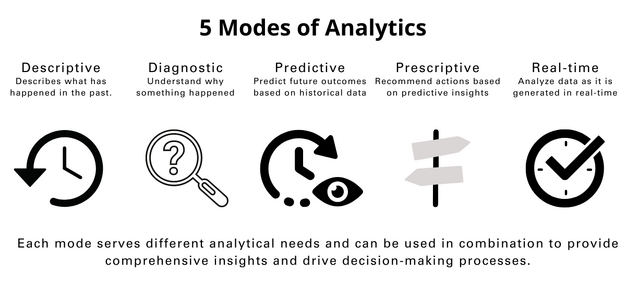AI Analytics Modes
From MDS Wiki

AI analytics encompasses a variety of modes, each suited to different types of data and analysis needs. Here are some key modes of AI analytics:
- Descriptive Analytics:
- Purpose: To describe what has happened in the past.
- Techniques: Data aggregation, data mining, and data visualization.
- Examples: Reports, dashboards, and data summaries.
- Diagnostic Analytics:
- Purpose: To understand why something happened.
- Techniques: Drill-down, data discovery, and correlations.
- Examples: Root cause analysis, anomaly detection, and statistical analysis.
- Predictive Analytics:
- Purpose: To predict future outcomes based on historical data.
- Techniques: Machine learning, regression analysis, and time series analysis.
- Examples: Sales forecasts, risk assessments, and customer behavior predictions.
- Prescriptive Analytics:
- Purpose: To recommend actions based on predictive insights.
- Techniques: Optimization algorithms, simulation, and decision analysis.
- Examples: Resource optimization, personalized marketing, and supply chain management.
- Cognitive Analytics:
- Purpose: To simulate human thought processes in analyzing complex data.
- Techniques: Natural language processing (NLP), machine learning, and deep learning.
- Examples: Chatbots, virtual assistants, and automated content generation.
- Real-time Analytics:
- Purpose: To analyze data as it is generated in real-time.
- Techniques: Stream processing, event processing, and in-memory computing.
- Examples: Real-time fraud detection, live customer support analytics, and instant recommendation systems.
- Edge Analytics:
- Purpose: To analyze data at the edge of the network, close to where it is generated.
- Techniques: Local processing, edge computing, and embedded AI.
- Examples: IoT device analytics, autonomous vehicles, and smart sensors.
- Augmented Analytics:
- Purpose: To enhance data analysis with AI-driven insights and automation.
- Techniques: AI-powered data preparation, automated insights generation, and NLP for data querying.
- Examples: Self-service BI tools, automated data storytelling, and AI-assisted data exploration.
Each mode serves different analytical needs and can be used in combination to provide comprehensive insights and drive decision-making processes.
